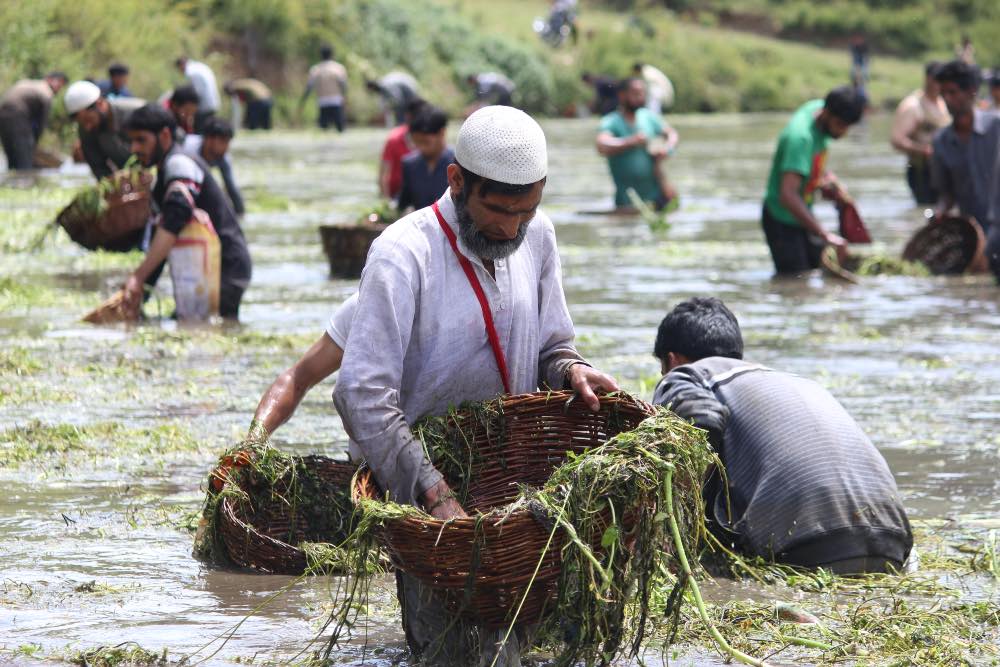
A severe heatwave, accompanied by rising temperatures, is threatening the aquatic life in Kashmir’s lakes and streams, experts warned on Wednesday.
They said the increasing temperatures are disrupting the delicate balance of the region’s aquatic ecosystems.
“Fish are highly sensitive to changes in water temperature; even slight increases can affect their metabolism, growth, and reproductive cycles,” experts said, adding that the heatwave is causing water levels to drop and oxygen levels to decrease, creating a hostile environment for fish and other aquatic species.
They said if these conditions persist, we could see a decline in fish populations, which will have a ripple effect on the entire ecosystem.
The Kashmir Valley has experienced several mass fish mortality incidents in recent years. For instance, in August 2012, numerous fish died in Srinagar’s Nigeen Lake due to low oxygen levels and changes in water temperature. In October 2017, thousands of fish were found dead in the Jhelum River, again due to low oxygen levels.
More recently, in July 2024, thousands of fish died in the Tsoont Koel stream near Barbar Shah, Srinagar, due to oxygen depletion and pollution.
According to the research titled “The Changing Water Quality of Lakes—A Case Study of Dal Lake, Kashmir Valley”, accessed by the news agency—Kashmir News Observer (KNO), the rate of dissolved oxygen in the lake has fallen drastically over the last 40 years, while the presence of phosphates and nitrates has increased due to the discharge of untreated sewage, agricultural runoff, and sediments from surrounding catchments.
The study highlights that Dal Lake has suffered extreme water quality degradation over the past four decades due to anthropogenic pressures, with harmful substances like phosphates, nitrates, and chlorides increasing significantly.
Shabeena Jan, a researcher, speaking to KNO, said that fish, being ectothermic (cold-blooded) species, have body temperatures and metabolic rates directly influenced by their environment’s temperature.
“As the water temperature rises, the metabolic rate of fish increases, leading to a higher demand for oxygen,” she said. “However, warm water holds less dissolved oxygen, creating a deadly combination for aquatic life.”
Shabeena said that pollution from agricultural pesticides and industrial waste increases the biological oxygen demand, further decreasing oxygen concentration in water bodies.
“During high heatwaves, the convection process is weak, resulting in anoxic conditions in water bodies and leading to the death of fish and other aquatic life,” she added.
Dr Mehraj Bashir, a well-known ichthyologist and Assistant Professor of the Zoology Department at SP College, Srinagar, told KNO that in the past, fish have died in water bodies like Dal Lake and the Jhelum River due to various factors.
“Water temperature up to 25°C is manageable. Beyond this, fish start to struggle, although they can tolerate up to 30°C. As temperature increases, oxygen consumption also increases. A water oxygen concentration of 10-15 mg/L is ideal,” he said.
Dr Mehraj said that pollution-induced weed growth increases oxygen demand, leading to lower oxygen levels that affect fish and other aquatic life.
He further said that heatwaves cause thermal stratification in lakes and streams, resulting in different temperatures at various depths, which can be fatal for small fish (fingerlings) and, to some extent, larger fish.
As temperatures rise, water holds less oxygen. Trout, which prefer 10-15°C, cannot survive higher temperatures. Other fish species in Kashmir, such as Schizothorax and carp, have varying tolerances. Schizothorax, native to Kashmir, is more delicate compared to carp, which can manage higher pollution and temperature levels. That is why Schizothorax fish numbers in Dal Lake have declined,” he said.
In this heatwave season, Schizothorax are found in upper hill streams due to the availability of fresh oxygen and water, Dr Mehraj added—(KNO)
